Exploring the intersection of spaceflight history, pop culture, and space art.
In this edition of Creating Space I share a large model of one of Grumman’s intermediate designs for the Apollo Lunar Module.
Are you new to Creating Space? It’s the NERDSletter that explores the intersection of spaceflight history, pop culture, and space art. You can find this and all other posts at creating-space.art.
Model of the Month
My latest acquisition is a space contractor model of unusually large size, and it will take up a good amount of space in my collection.
This is a model of the Apollo Lunar Excursion Module (LEM) as it looked on Grumman engineers’ drawing boards while it was still in the adolescent phase of its preliminary design. As best I can tell, the timing of this particular design falls somewhere between July 1963 and July 1964.
The model stands 22 inches (56 cm) tall. Its span, measured diagonally across opposing footpads, is 32 inches (81 cm). It weighs nearly 17-1/2 pounds (8 kg). It is made of wood, fiberglass, and metal.
The model maker is unknown to me. Given its size, one might guess it was created for display in a museum. There is some evidence this model was used for educational displays and/or demonstrations, as you will read further on.
The configuration of this model bears close resemblance to the LEM depicted in the 1967 children’s book called Moonshot 1970. I featured my artwork of that LEM (seen here) as well as the book in previous posts.
There are a number of features that point toward the final design, some that remain from earlier configurations, and other features that represent newer concepts that did not get carried forward in later versions.
Gone is the squat ‘bug’ from 1962 with the bulbous head and tiny legs. This version’s ascent stage now has a front ‘face’ that should look more familiar to those who have seen the final as-flown configuration. The engineers continued to reduce the size of the windows, now relatively small triangles that standing astronauts could use with their faces closer to the glass than in earlier seated arrangements.
The descent stage has taken on an octagonal shape, as in the flown configuration, and sprouts four legs rather than five – this time with wide dish-like footpads. The LEM has grown in size and weight relative to Grumman’s original design. As a result, the landing legs have been redesigned to take the added loads. Note, also, that the forward leg is centered in front of the hatch.
The distinctive round front and top docking ports are still held over from earlier configurations.

Sighting #1
I have seen several photos of this model in the wild which provide some clues as to how it was used.
One such photo is this one found on eBay a number of years ago.
The press photo shows an educational display with a model similar to mine sitting on a realistically simulated lunar surface. Behind the LEM are display graphics – somewhat out of focus in this photo – one seeming to show an Apollo Command Module descending under three striped parachutes, and one with a diagram of a Saturn V propulsion system (as best I can make out the text). There also appears to be a model globe of the Moon, or perhaps a Command Module, just off the left corner of the photo.
Resting on the front footpad is a sign card that reads:
“Lunar Excursion Module ... is the spacecraft that will land this country’s first Moon explorers on the lunar surface. Two independent engine systems will enable the craft to gently touch down on the Moon’s surface and later return to lunar orbit for rendezvous with the Command-Service Module.”
The date stamped on the back is “NOV 19 1966”. The original handwritten note on the back reads “Luna [sic] Excursion Module”.
Sighting #2
Here’s a photo of a model like mine being viewed by four gentlemen. I can identify two of them. Thomas Paine, third from left, was the NASA Administrator from March 1969 to September 1970. To his right is Dr. Hans Mark, Director of NASA’s Ames Research Center, from 1969 to 1977. He was Deputy Administrator from 1981 to 1984. This photo was taken on Dr. Mark's first day as Director of the NASA Ames Research Center.
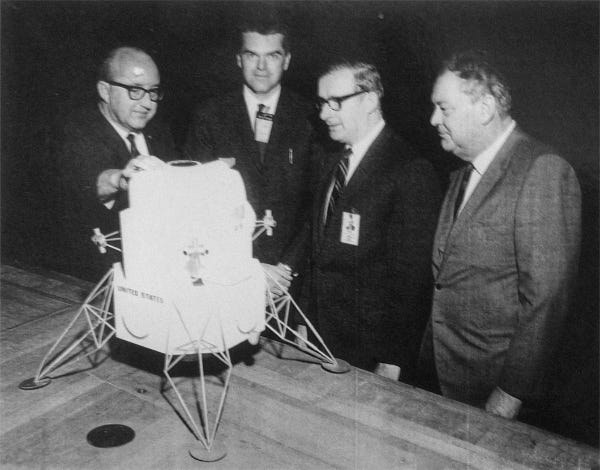
Sighting #3
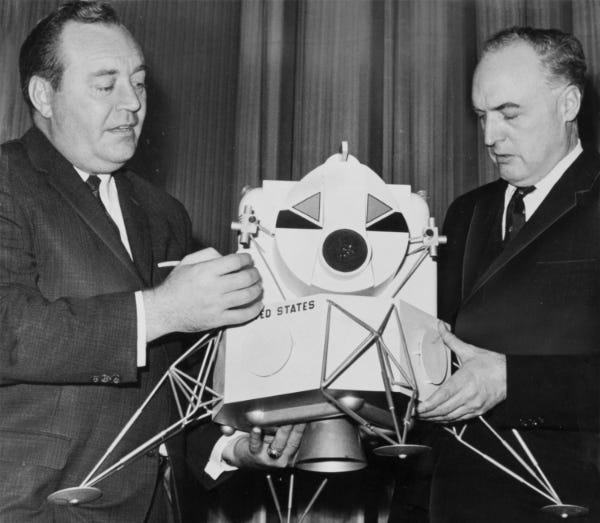
This press photo came with my model when I purchased it. It is from The Daily Telegraph, a British newspaper, dated February 25, 1966. It shows, according to the copy on the reverse side, Julian Rogers, a NASA scientist, on the left holding an example of the model with the assistance of L. J. Carter of the British Interplanetary Society. The photo was taken at the American Embassy in London. The model was part of a mobile exhibition on space research by NASA which toured schools in Britain.
Not one to shy away from going down a space rabbit hole, I decided to do some research into Mr. Rogers. It turns out that Julian Rogers was an educational demonstrator for NASA. After serving in the U. S. Navy, he joined NASA in 1963 and was known as a lecturer to schools and organizations in the United States and Europe. The literal vehicle for his lectures was the NASA ‘Spacemobile’.
Which leads me to ...
Sighting #4
The NASA Spacemobile was a traveling educational outreach program intended to foster interest and educate the public about space exploration. Lecturers, such as the aforementioned Julian Rogers, brought exhibits, models and other resources to communities throughout the 1960s in distinctively decorated vans.
Formally known as the Aerospace Education Services Program (AESP), the Spacemobiles were once an iconic part of NASA's outreach to the public.1
My school was never visited by the Spacemobile when I was growing up. But, I can tell you that if I saw the Spacemobile and the ice cream truck both coming down my street, I would definitely be running toward the Spacemobile.
Here we see a model like mine at a Spacemobile presentation along with some other very impressive models doing their part to excite and inspire young minds about spaceflight.
As a collector of such models, I can’t help but wonder if some of those other models might one day come up for sale at a future auction. For instance, I think that Command/Service Module would look pretty good next to my LEM.
Or ... why not get the combined set?
In the Room When History Was Made
Models like this one, depicting a point in time in the early development of the spacecraft that permitted those first small steps on the Moon, are great examples of how engineering designs evolve as they go from concept to refined final products. They exemplify the type of engineering I devoted my career to.
Finding these models is a thrill for me, especially when they are within buying range. The photos showing them in context give the experience added depth. They were “in the room” when history was being made. They may have been viewed or handled by some of the people who made that history happen. And, with a little research, they can introduce me to others whose names may be somewhat less prominent in the historical record.
Merch of the Month
Moonshot 1970: Moments to Touchdown Acrylic Block
Admit it, this lunar module acrylic block would look great on your desk. It’s the next best thing to having a giant model. ;-)
As a special thank-you for reading Creating Space, I am offering a discount on my artwork. Simply use code CREATINGSPACE15% for 15% off your entire order from the Pixel Planet Pictures shop.
My space-inspired art portfolio can be found at pixel-planet-pictures.com. You can also follow me on Instagram (pixelplanetpics).
Do you know fellow Space Geeks who might enjoy Creating Space? Invite them into this space, too!
Did you miss a post? Catch up here.
If you enjoyed this article please hit the ‘Like’ button and feel free to comment.
All images and text copyright © Dave Ginsberg, unless otherwise noted. All rights reserved.
OSU NASA Education Project History, OSU/NASA History, Oklahoma State University


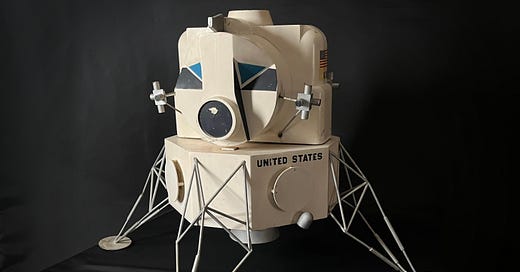



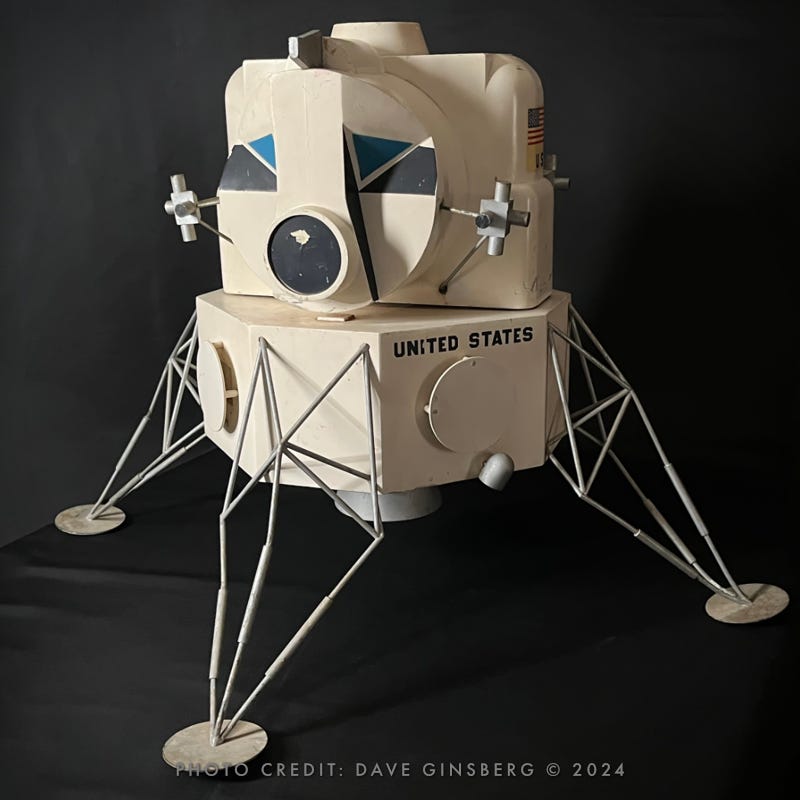
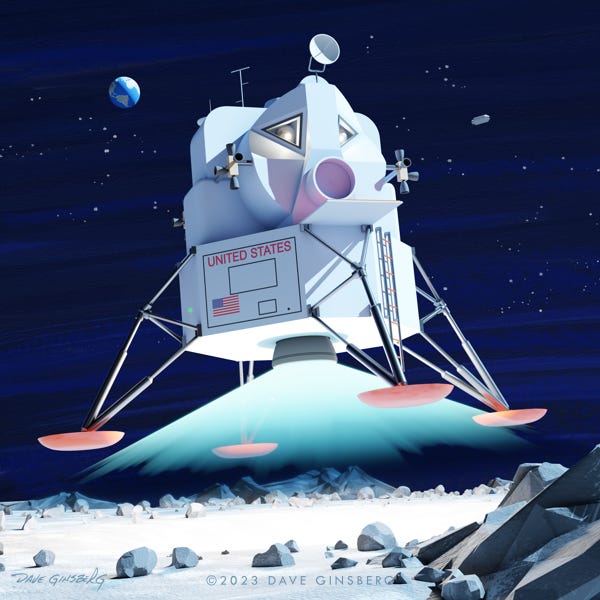
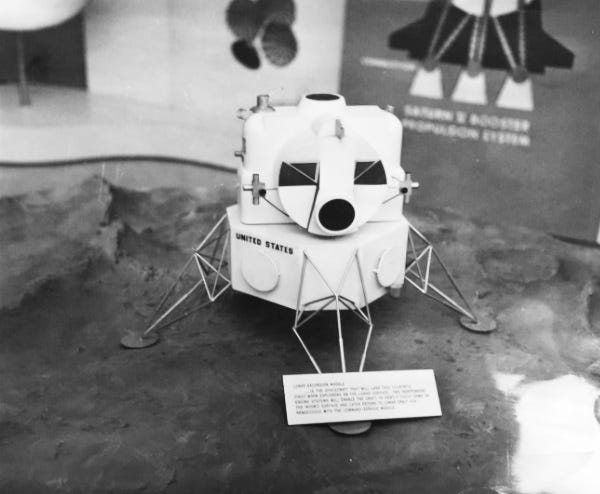
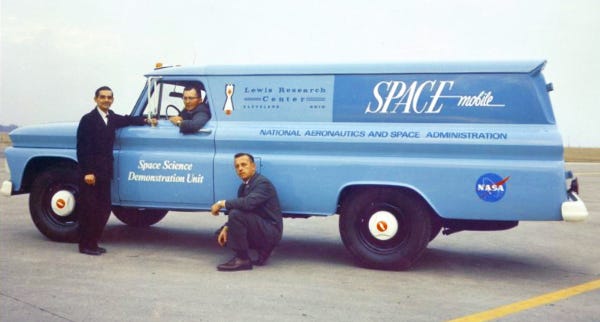
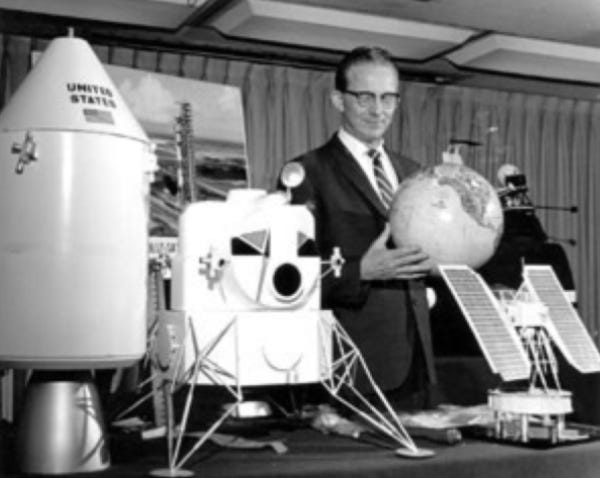
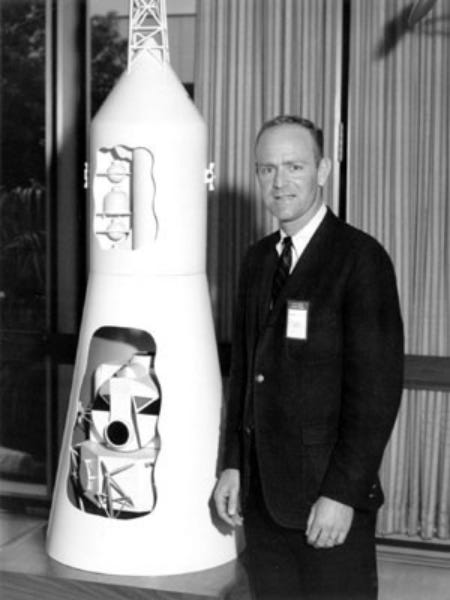

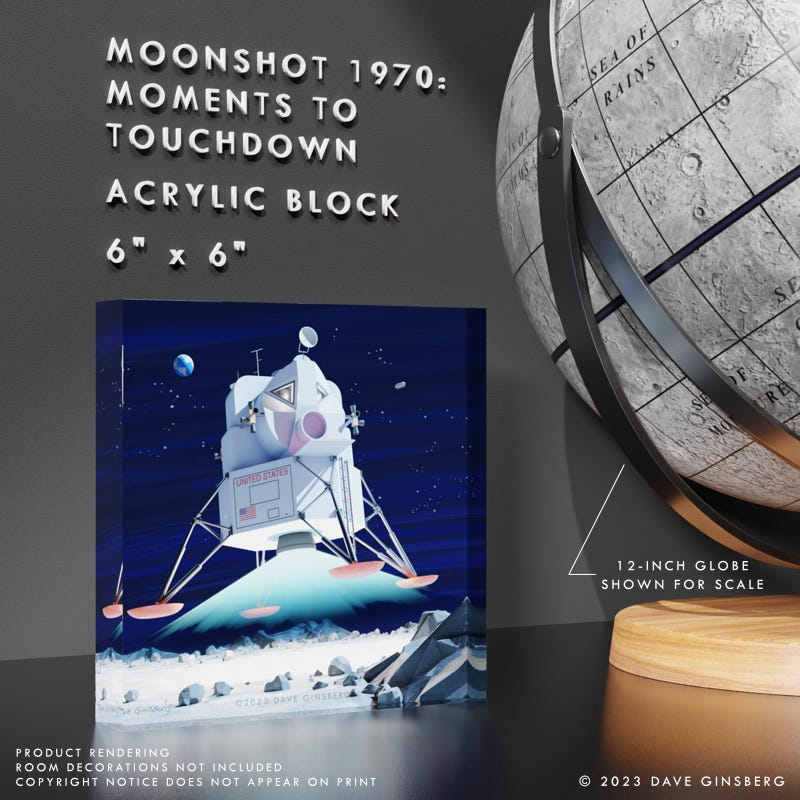





17-1/2 lbs. What’s not to like?
Dave this is a wonderful story! Congrats on "your" model and I hope one day you can acquire the stack mode for your collection. It would be really awesome if someone with the skills could make you a Saturn V to mate with that stack! Of course you'd have to put it in a stairway to the 2nd floor! That would be a nice problem to have!! Have you read the book CHARIOTS FOR APOLLO by Charles R. Pellegrino and Joshua Stoff? It's a great story on the LEM.